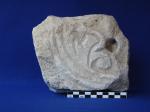
Illustrations
- No uploaded files
Description
- Medieval low relief
- White marble
- 1
- 16.0
- 13.0
- 12.0
- The fragment is worn and broken on all sides. Fine cracks crisscross the carved surface, which is also pierced by a circular hole (2.5 cm in diameter and approximately 3 cm deep). It was cut into a roughly rectangular block for reuse as construction material or to be burned for lime.
- The front face of the block preserves a highly stylized acanthus leaf clumsily carved in low relief. The leaf curves in a semi-circular arc; two tear-shaped fronds and a curling tendril emerge from the arc's interior.
- This motif can be counted among the stock patterns of the period. Rudolph Kautzsch (1939, 17–9) noted its early (eighth-century) appearance in the north, in the vicinity of Milan and provided a number of examples and variations including S. Prassede (817–24), S. Maria in Trastevere (now in the portico) and a fragment from the Cathedral of Anangi (now attached to the façade) (Kautzsch 1939, 17–8, figs 29–31; for the S. Prassede piece see also Pani Ermini 1974, no. 61). Nearby examples can be found in cathedral of SS. Giovanni and Paolo, Ferentino (Ramieri 1983, nos 38 and 40).















![Download [view]](/villamagna/ark//skins/villamagna/images/results/download_sml.png)